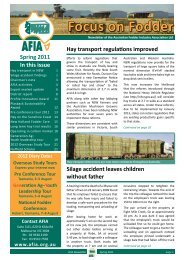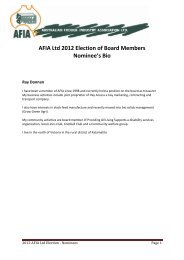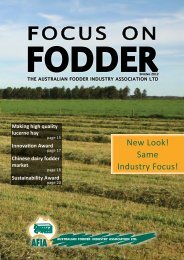AFIA - Laboratory Methods Manual - Australian Fodder Industry ...
AFIA - Laboratory Methods Manual - Australian Fodder Industry ...
AFIA - Laboratory Methods Manual - Australian Fodder Industry ...
You also want an ePaper? Increase the reach of your titles
YUMPU automatically turns print PDFs into web optimized ePapers that Google loves.
Reagents:<br />
1. Neutral Detergent Solution (NDS), prepared as follows (all chemicals reagent grade):<br />
Note: A total of 2.0 L of NDS should be used during all digestions regardless of the number<br />
of samples. The following formula gives weights required for 1.0L.<br />
Note 2: If bulk solutions are made and stored prior to use, care MUST be taken to ensure that all<br />
components are mixed back into the solution before any solution is decanted. Failure to do<br />
so may result in significant error.<br />
a) Place 18.61 ± 0.01 g of EDTA (disodium ethylenediaminetetraacetate, C 10 H 14 N 2 Na 2 O 8 x<br />
2H 2 O) and 6.81 ± 0.01 of sodium tetraborate decahydrate (Na 2 B 4 O 7 x 10H 2 O), in a<br />
beaker and add some distilled water and heat until dissolved.<br />
b) Add 30.0 ± 0.1 g sodium lauryl sulphate (C 12 H 25 OSO 3 Na), 10.0 ± 0.1 mL of triethylene<br />
glycol and 4.56 ± 0.01 g disodium hydrogenphosphate (Na 2 HPO 4 ).<br />
c) Add water and heat until dissolved. Mix and dilute to 1000 mL. Check pH which should be<br />
in the range 6.9 - 7.1.<br />
2. Sodium sulphite, anhydrous<br />
3. Alpha-amylase, 17,400U/mL, Heat-stable, ANKOM #FAA standardised as per Appendix<br />
1.8R(1).<br />
4. Distilled water (dH2O)<br />
5. Acetone<br />
Procedure:<br />
Note: Analyses are performed only on samples previously dried at 55 to 60 o C (maximum) and<br />
ground to pass a 1 mm screen. Operators should wear gloves when handling filter bags.<br />
1. Weigh the filter bag, record weight (W1) and then zero balance. The bags have negligible<br />
moisture content and do not need to be pre-dried.<br />
2. Weigh 0.50 ± 0.05 g, of well-mixed laboratory dry sample directly into filter bag. Record weight<br />
to at least 0.1 mg (0.001 g) accuracy (W2).<br />
3. Seal the bag closed within 1 cm of the open edge using the heat sealer. Weigh and seal one<br />
empty bags to be run as blanks during analysis.<br />
4. Spread sample uniformly inside the filter bag. This should be done by shaking and lightly<br />
flicking the bag to eliminate clumping.<br />
5. Weigh a second sub-sample for laboratory dry matter determination.<br />
6. Pre-extract lipid from all samples with acetone. Place bags into a glass container with a lid.<br />
Pour enough acetone into container to cover bags and secure top. Shake the container 10<br />
times and allow bags to soak for 10 min. Repeat with fresh acetone. Pour out acetone and<br />
place bags on a wire screen to air dry.<br />
7. The Bag Suspender is composed of nine individual baskets, one centre post and one spring.<br />
Place three bags per basket, maximum 24 bags per run and stack baskets on centre post,<br />
each basket rotated 120 degrees from previous one. The ninth basket remains empty and<br />
acts as a top for the eighth basket.<br />
<strong>AFIA</strong> <strong>Laboratory</strong> <strong>Methods</strong> <strong>Manual</strong> – v7 September 2011 Page 46 of 103







